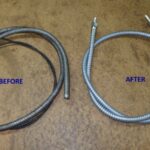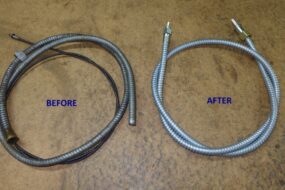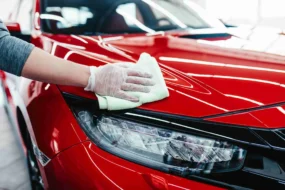Loosening the bolt of a clamp connector.
A faint click or total silence when the starter key is turned usually means that the battery is almost or completely flat. If, however, the battery is fully charged, the trouble is probably in the circuit between the battery and starter.
Either way, lack of power is preventing the starter motor from working – though there may be just enough current to work the solenoid, which makes a faint click or chatter.
If you suspect the circuit, look first at the battery-terminal connections. Unless they are in good condition, the current cannot flow through them properly – and sometimes not at all.
The most common types of connector are a clamp that fits around the battery post, or a cup that fits over it. The clamp is secured by a bolt; the cup by a screw into the top of the post.
The Ford type has a flat cable connector bolted to a flat battery post.
The mating surfaces of both connectors and battery posts must be free from dirt and corrosion.
Any green or white powdery deposits must be removed, and the metal surfaces beneath brightened.
Remove these deposits also from the battery carrier or any other metal parts – they are very corrosive.
If cleaning the terminals does not cure the trouble, examine the earth lead – particularly where it is attached to the body or chassis, and clean if necessary. There must be a bare-metal contact for proper earthing.
Some cars have another earth lead between the engine and the body or chassis. Be sure to examine it also.
Look also at the starter motor and solenoid for loose connections, which can cause sparking. This is a fire hazard in any circuit, but becomes an even greater one in the battery-starter circuit, which has around 300 amps flowing through it.
Make sure that the battery is not loose in its mounting, or electrolyte may spill out and cause corrosion.
The battery leads can also work loose, or the case may crack through being bumped about. A loose clamping bracket can touch the live terminal of the battery and cause a short circuit.
Removing battery connectors
Loosening the bolt of a clamp connector.
Prise the jaws apart with a screwdriver.
Clamp or cup connectors can be removed after unscrewing the securing bolt or fixing screw. But take care if the connectors have been tightly fixed on.
Avoid prising them off or trying to twist them loose – undue force and damage the battery posts or their seal with the top of the case.
A screwdriver can be used to force apart the jaws of a clamp connector.
The Ford type is removed simply by unscrewing its nut and bolt.
Similar precautions should be taken when refitting. Do not hammer the connector down over the post.
When you use a spanner on a clamp or connector bolt, take care to keep the free end away from the car bodywork, where it can cause a short circuit – even is the engine is switched off.
A cup connector secured to the terminal post by a screw through the top.
Unscrew the nut and bolt of a ford-type connector.
How to clean battery terminals
‘Brighten’ the battery posts with emery cloth.
Clean up the connector with a wire brush.
Filing metal from the jaws of a clamp connector.
Cleaning the inside of a cup connector.
Use hot water and domestic soda to start removing the powdery deposits that may form on terminals. But be sure that none of this solution finds its way into the battery cells.
The battery posts can be ‘brightened’ with a wire brush or emery cloth.
Do not, however, remove so much metal that the cup or clamp becomes a loose fit on the post.
If that does happen, some metal can be filed from the jaws of the clamp, or the sides of the cup can be squeezed in a little, so that it grips the post once more. Alternatively, replace a cup connector with a clamp type.
Refitting the connectors
Use solder wire to fill out the screw hole in a battery post, if the hole is too large.
Smear a thin coat of petroleum jelly (not grease) on the mating surfaces of both the battery posts and connectors before refitting, to deter corrosion and ensure good conductivity.
Ideally, the cup or clamp should be an easy push fit over the post. Tighten the securing bolt or screw enough to stop the connector moving on the post, but do not overtighten.
Squeezing the sides of a cup connector to tighten the fit.
If a cup-connector screw does not tighten because the thread has been stripped, put a length of solder wire into the hole to fill it partly.
A self-tapping screw should then cut a new thread with enough bite to hold the screw firm. Or simply use a larger self-tapping screw.
Smear petroleum jelly over the battery posts.
Smear petroleum jelly also on the connections at the other ends of the battery leads — in most cases the starter solenoid and the earthing point on the body/chassis.







